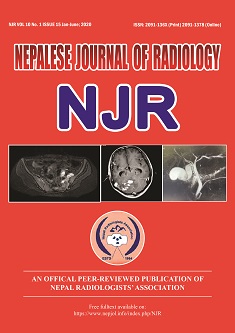Radiological Spectrum of Active Sacroiliitis by Conventional Radiography and MRI
DOI:
https://doi.org/10.3126/njr.v10i1.27768Keywords:
Ankylosis, Bone Marrow, Bursitis, Sacroiliitis, SpondyloarthritisAbstract
Introduction: The aim of the present study was to compare the role of Conventional Radiography and Magnetic Resonance Imaging (MRI), in diagnosis of active sacroiliitis and differentiation between inflammatory and infective sacroiliitis.
Methods: Fifty two cases of active sacroiliitis diagnosed on MRI from August 2017 to August 2019 were included in study. All the patients were subjected to conventional radiology, MRI and findings were co-related with clinical and laboratory findings. Conventional radiography was used to evaluate structural changes. MR images were evaluated for bone lesions (extent and distribution of bone marrow edema and presence of bone erosions), soft-tissue lesions (capsulitis, extra capsular fluid collections, and peri-articular muscle edema) and joint space reduction for differentiation between infective and inflammatory etiology.
Results: Conventional radiography showed sclerosis, erosion, partial and complete ankylosis. Thick capsulitis, extra capsular fluid collection, and peri-articular muscle edema were all more frequently observed in infective sacroiliitis (p<0.001). Iliac-dominant bone marrow edema more common in spondyloarthritis (p<0.001). When periarticular muscle edema was the sole predictor, unilateral sacroiliitis in spondyloarthritis was correctly identified in 79.16% of cases, and infectious sacroiliitis was correctly identified in 82.14% of cases.
Conclusions: MRI is the optimum imaging modality to diagnose active sacroiliitis. MRI plays an essential role in better demonstrating early alterations and inflammatory activity and aid in differentiation of infective and inflammatory sacroiliitis. Conventional radiography with low sensitivity can be used as a screening tool and follow-up of patients with sacroiliitis.
Downloads
Downloads
Published
How to Cite
Issue
Section
License
This license enables reusers to distribute, remix, adapt, and build upon the material in any medium or format, so long as attribution is given to the creator. The license allows for commercial use.




